Analyzing Z370 for Intel's 8th Generation Coffee Lake: A Quick Look at 50+ Motherboards
by Ian Cutress, Anton Shilov, Joe Shields & Gavin Bonshor on October 20, 2017 2:00 PM ESTASRock Z370M-ITX/ac and Z370 Gaming-ITX/ac
The last two ASRock boards left in their current Z370 lineup are the Z370M-ITX/ac and the Z370 Gaming-ITX/ac. While their pedigree is a bit different, with the latter coming from the Gaming line, they are both mini-ITX sized boards intended to fit in small form factor cases. Due to the size, neither SLI nor Crossfire support is possible due to only one PCIe slot in place, but the idea for this size is to have a small powerhouse. The Gaming-ITX/ac will have more or higher-end features and will come in at a higher price point out of the two, because it also has an onboard Thunderbolt 3 chip.
The Gaming-ITX board, as all mITX sized boards seem to, look pretty cramped as there is very little free space on the board. This board uses a heatpipe to connect the power delivery heatsink to the chipset heatsink, with the Thunderbolt controller also taking advantage. Only the Gaming-ITX has a reinforced PCIe slot at the bottom of the board, which is rated to PCIe 3.0 x16 from the processor. As far as overall looks, there isn’t really a theme so much as it is a black PCB with a lot going on in a small space. The board does have red LEDs on the bottom by the PCIe slot and does and an RGB header for adding additional flare.
The Z370M-ITX also doesn’t have much in the way of beautification going either. On this board all six of its power delivery phases have a heatsink, but it is noticeably smaller than the one in the Gaming-ITX and is not connected via a heatpipe to the chipset heatsink (which is also slimmed down). Due to the smaller chipset heatsink, the M.2 slot on the Z370M-ITX is located on the front of the board, just above the non-reinforced PCIe slot, rather on the rear.
Memory capacity is limited to one module per channel, due to having two slots instead of four because of the size. Similar to the other ASRock boards, the quoted speeds for these two boards are higher than the other vendors, with the Gaming version supporting DDR4-4333 and the standard Z370M-ITX going for DDR4-4000. Interestingly for the PCIe slot, the Gaming-ITX/ac specifications does mention support for PCIe riser cards to extend one x16 slot to two x8 slots, should users have access to an appropriate riser card. That being said, the system does not ship with SLI certification, and thus support may be limited to Crossfire in this scenario.
Both boards have a single PCIe 3.0 x4 based M.2 slot, with the Z370M-ITX having it on the front and the Z370 Gaming-ITX on the rear. Despite some of the larger boards from other vendors having only four SATA ports, ASRock goes for all six on both of the mini-ITX boards, and placed such that interlocking cables should not interfere with each other if drives need to be removed.
For fan headers, they each have three, with ASRock's 'CPU Optional/Water Pump' fan header able to output 1.5A/18W. Both of them also have Wi-Fi modules, although the one in the Gaming uses the Intel AC8265 while the Z370M-ITX uses the AC3165. The boards differ in audio, with Gaming-ITX/ac using the Realtek ALC1220 and adding all the bells and whistles from the Gaming line (Nichicon Gold Series audio caps, T.I NE5532 headset amplifier), compared to the Z370M-ITX which uses a Realtek ALC892. The boards also differ on networking in favor of the Z370M-ITX which has dual Intel (I219-V, I211-AT) whereas the Gaming-ITX only has one (I219-V).
The key difference in the support between the two boards is going to be the Thunderbolt 3 port on the Gaming-ITX. This port supports video outputs and USB 3.1. Other USB support on the back panel of the Gaming-ITX/ac is provided by the six USB 3.1 (5 Gbps) ports. Elsewhere on the panel is a combination PS/2 port, a clear CMOS button, the antenna connectors, HDMI video output, DisplayPort video output, the ethernet connection, the audio jacks, and SPDIF.
For the Z370M-ITX/ac, there is no Thunderbolt port, but in its place are two HDMI ports. This comes with the DisplayPort to round out the video outputs. USB connectivity comes from two USB 2.0 ports and six USB 3.1 (5 Gbps) ports. The two network ports look fairly ominous, but are paired with the Wi-Fi module just next door. The audio supplies three jacks, with no SPDIF here.
| ASRock Z370 Gaming-ITX/ac and Z370M-ITX/ac | ||
| Z370 Gaming ITX/ac | Z370M-ITX/ac | |
| Warranty Period | 3 Years | |
| Product Page | Link | Link |
| Price | Amazon US | Amazon US |
| Size | ATX | |
| CPU Interface | LGA1151 | |
| Chipset | Intel Z370 Express | |
| Memory Slots (DDR4) | Two DDR4 Supporting 32GB Dual Channel |
|
| Support DDR4-4333 | Support DDR4-4000 | |
| Network Connectivity | 1 x Intel I219-V Intel AC8265 Wi-Fi |
1 x Intel I219-V 1 x Intel I211-AT Intel AC3165 Wi-Fi |
| Onboard Audio | Realtek ALC1220 | Realtek ALC892 |
| PCIe from CPU | 1 x PCIe 3.0 x16 slot | |
| PCIe from Chipset | None | |
| Onboard SATA | 6 x Supporting RAID 0/1/5/10 | |
| Onboard SATA Express | None | |
| Onboard M.2 | 1 x PCIe 3.0 x4 | 1 x PCIe 3.0 x4 |
| Onboard U.2 | None | |
| USB 3.1 (10 Gbps) | 1 x Type-C (via Thunderbolt) | None |
| USB 3.1 (5 Gbps) | 6 x Back Panel 1 x Header |
|
| USB 2.0 | 1 x Header | |
| Power Connectors | 1 x 24-pin EATX 1 x 8-pin ATX 12V |
|
| Fan Headers | 1 x 4-pin CPU (1A/12W) 1 x 4-pin CPU Opt (1.5A/18W) 1 x 4-pin Chassis Fan |
|
| IO Panel | 2 x Antenna ports 1 x Combo PS/2 1 x HDMI port 1 x DisplayPort 1.2 1 x Intel TB3 (Type-C) 1 x Optical SPDIF out 6 x USB 3.1 (5 Gbps) 1 x RJ-45 LAN port 1 x Clear CMOS button 6 x Audio Jacks |
2 x Antenna ports 1 x Combo PS/2 2 x HDMI ports 1 x DisplayPort 1.2 2 x USB 2.0 ports 6 x USB 3.1 (5 Gbps) ports 2 x RJ-45 LAN ports 3 x Audio Jacks |


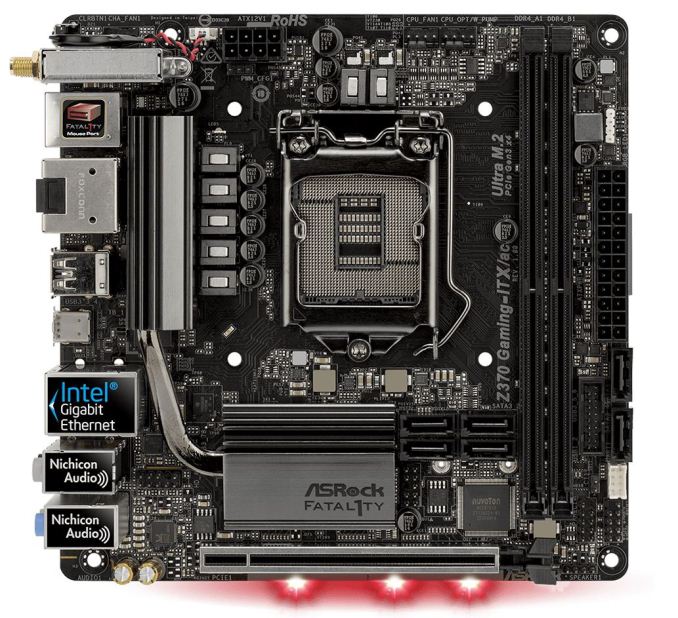
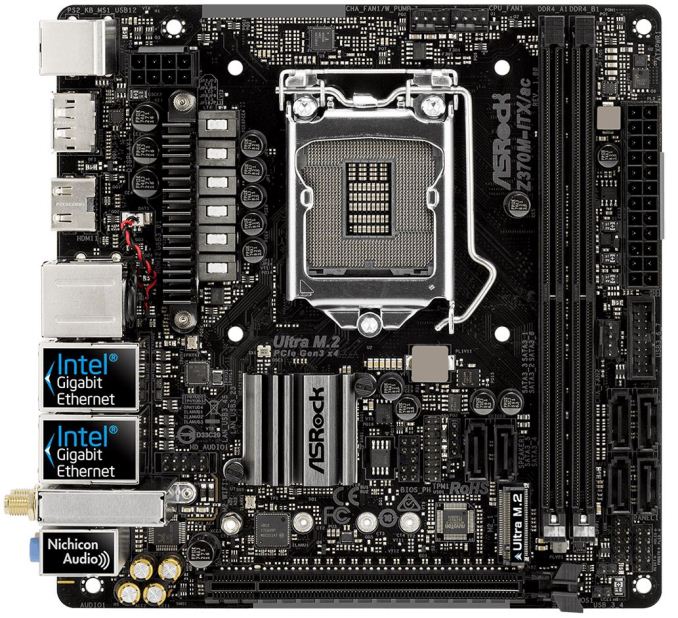
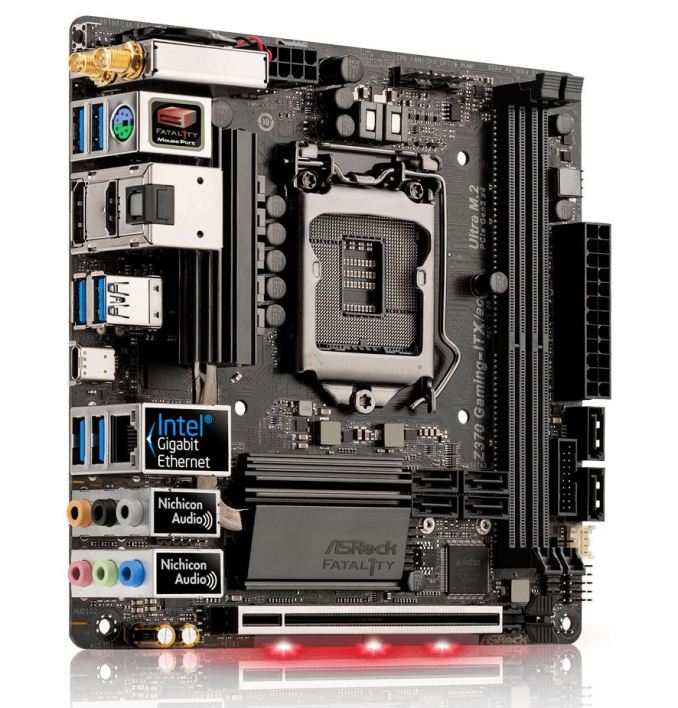
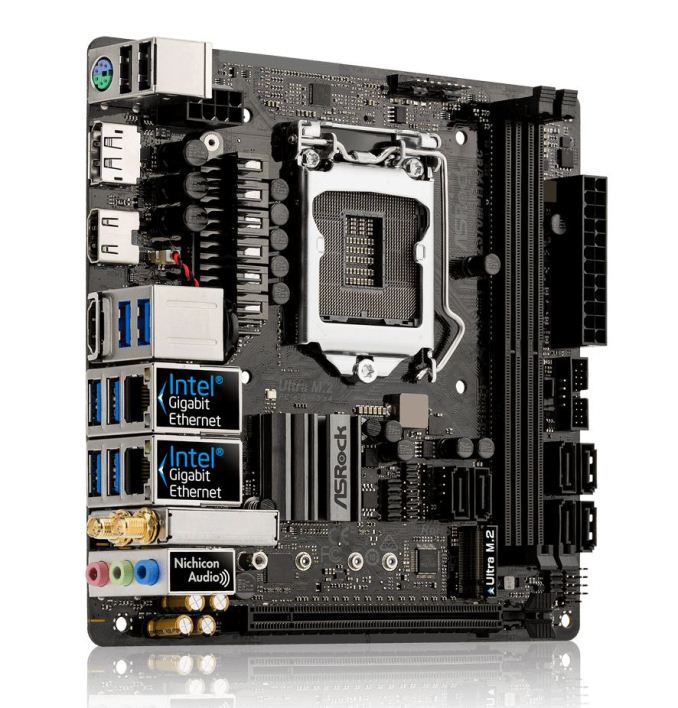
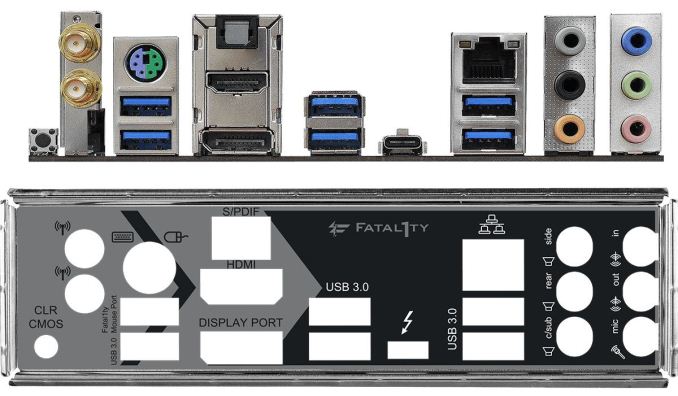









83 Comments
View All Comments
weevilone - Wednesday, October 25, 2017 - link
Notable that though the new boards are often very similar to their Z270 predecessors, Asus has dropped Thunderbolt 3 support from the Maximus X Hero board.masouth - Thursday, October 26, 2017 - link
ASUS ROG Z370 Maximus X Hero"....new metallic heat sinks that are an upgrade over the plastic heatsinks found on the Z270 version"
Please excuse my ignorance because I didn't own a ROG Z270 mb but...plastic HEAT SINKS? Not shrouds or decoration over a heat sink but the actual heat sinks themselves? That's either wrong, they performed their job pretty poorly, or plastic resins have advanced a lot farther in thermal conductivity (and cost for such) than I realized.
flowrush - Sunday, November 19, 2017 - link
"The other main distinguishable feature is the inclusion of integrated 802.11ac Wi-Fi with an antenna (that can only be described as a shark fin) found on the F."The above is incorrect in the article. The integrated Wi-Fi module with antenna is found on the E not the F.
Coldgame - Saturday, November 25, 2017 - link
I'm looking to build a rig with the Z370 Gaming ITX/ac, a GTX-1070 card and an Apple Thunderbolt Display.The review states:
"The key difference in the support between the two boards is going to be the Thunderbolt 3 port on the Gaming-ITX. This port supports video outputs..."
So, can anyone confirm or deny that video generated by the GTX-1070 can be output through the onboard Thunderbolt 3 port?
hanselltc - Sunday, December 3, 2017 - link
Looking forward to low-middle end mITX choices from this platform. It'll probably be paired with a 8100/8300 and be my secondary machine.Roen - Sunday, February 4, 2018 - link
Where are the 10 Gbps ports on the back? They all look like 5 Gbps ports, even the Type C.rbarak - Wednesday, February 21, 2018 - link
Is anyone using the Z370-P on Linux with two screens?I built a new machine based on the Z370-P, and both the DVI and the HDMI connected screens show the same image, and the RHEL7 setup/displays show only one Unknown Display.
I follwed the advice on stackexchange, and added this line:
$ grep GRUB_CMDLINE_LINE_DEFAULT /etc/default/grub
GRUB_CMDLINE_LINE_DEFAULT="i915.alpha_support=1"
Then I did:
sudo grub2-mkconfig -o "$(readlink /etc/grub2.conf)"
And rebooted, but still, the two displays are not shown.
dromoxen - Wednesday, May 9, 2018 - link
Shocked to see that both the Asrock mitx boards are "szie=ATX" .. LOLThe addition of Tunderbolt sure seems to add a hefty premium £120 vs £160 , luckily I can do without.
Kroebo - Sunday, October 7, 2018 - link
Sadly, I discovered that the ZUG Gaming PLUS doesn't support SLI.trag - Tuesday, January 15, 2019 - link
On the ASrock Z370M Pro4 the M.2 slot information is backwards. Both slots support NVME. One slot also supports SATA. As written, "The first M.2 slot is SATA only while the second supports PCIe." it seems to say that one slot is SATA only and the other slot is PCIe (NVME) only.